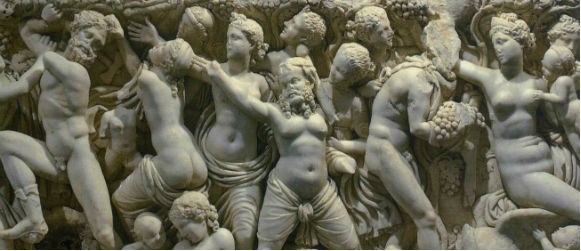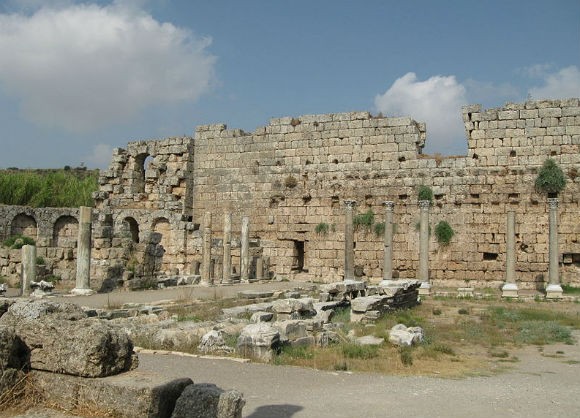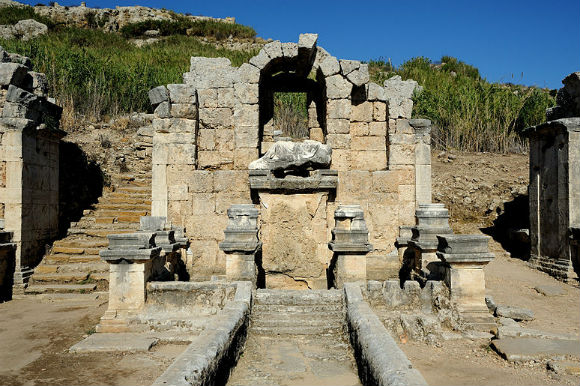Perga was an old city even in the first century. Its name (which is not Greek) indicates that its origin dates from pre-Greek times. Alexander the Great passed through it twice while the Pergaeans offered no resistance to him although it was a walled city with a citadel. In Roman times the main streets were over twenty-one meters wide. They were lined with Ionic colonnades and a water channel ran down their center in a series of small waterfalls as in Antalya today. Behind the colonnades stood the shops. Of the early buildings the stadium and the theater have survived the ravages of earthquakes and wars with the least damage. In fact this stadium which could seat about fourteen thousand people is one of the best preserved in Turkey.
The temple of the Pergaean Artemis according to a writer of the time was “a marvel of size, beauty, and workmanship.” Its location has yet to be established; it may have been where there are now ruins of a Byzantine church on a hill to the southeast of the city.
Perga is on a rise not far from the Cestrus River which was navigable In Paul’s time. It was not a seaport in terms of Its being directly on the Mediterranean even then, but rather it was more easily defended where it was: its distance from the open sea made it less vulnerable to piracy.
Two people stand out among the early residents of Perga. Apollonius was a third century B.C. astronomer and mathematician who believed that the movements of heavenly bodies in the universe were explainable by orbits within orbits: that the moon went around the earth as the earth went around the sun. He was much ahead of his time in his theories of astronomy, so much so that the ideas had to be rediscovered during the Renaissance. Plancia Magna was unusual for a second century A.D. woman: she held the highest city office during her life, that of demiurgus. She must have been well-to-do for a number of inscriptions record her gifts to the city.
Paul and Barnabas went through Perga on their way to and from Antioch on their first journey (Acts 13:13, 14:25). John Mark was with them at first but left them at Perga to return to Jerusalem. The reason for that must have been such that Paul doubted his commitment to the cause. Later when Paul and Barnabas were about to start on their second journey from Antioch they had a sharp dispute over his worthiness. Paul refused to have him go along, so John and Barnabas went to Cyprus while Paul chose Silas to accompany him.
Paul talks in II Corinthians 12:7 and in Galatians 4:13-14 of bodily illness that brought him to Galatia the first time. It may have been on that account that he did not stay long in Perga the first time. Whatever the illness was, it seems to have improved in time in the dry mountain air to the north.
The second theory of why they did not stay long in Perga is that their interview with Sergius Paulus, the proconsul of Cyprus, had made them want to hurry to the Roman colony in Antioch of Pisidia. This interpretation may lay too much stress on the lasting importance of that meeting with a cultured Roman who could have been more interested in the pursuits of the mind than the salvation, in Christian terms, of his soul. It is interesting, however, that this is” the point in Acts (13:9) that Luke begins to call Paul by his Roman name, not his Jewish “Saul”.
On their return they did stay in Perga long enough to preach and talk with people there. Nothing else is told about the city or their time there.
Perga,






we love anything about Rome ruins, Perge Antalya is a must to see, the site is well preserved and some undergoing excavation on the site.
We spent 2 hours just admire how magnificent this site is, we just did not want to leave.
Wonderful !
The remains of the ruins have been well preserved especially the baths. You can still make out the marble that these baths were covered in. You also get to see the underground heating, amazing! You get a real feel for what this place may have looked like back in the day. Its a must see if you are in the…
A brill tour guide and such vast info on the baths and even the tracks wore into the ground from the horse cart wheels, the perfect alignment of the columns, everything. The carvings on the crumbling pieces of stone on the ground even with cherubs. great day go if you get the chance
Good value for money, amazing ruins- expensive ice creams
A very good site with plenty of Roman ruins in a very good state of disrepair if you know what I mean. Entrance was 10TL per adult, kids free. Lots of columns, roman baths, gates, central square that allow you to imagine life as a roman. well worth a visit.
Superb site, very well preserved and fascinating history.
I was told this site was in one of the best conditions, and it was. It was hard to believe how old this places is. Lots of building parts are laid out to continue the restoration work, and there was digging still going on at the end furthest away from the entrance gate. The rows of well-preserved columns cannot fail…
i saw many ruins but here is a real city with agora, hammams, central heating system in living places, waterways and theatre… everyone must see…
We visited the ruins of Perge on January 23rd as part of a Best of Turkey tour. The visit was enhanced by the information provided by our guide, who recounted the attractions of the city. We were delighted to learn that St. Paul preached on this city, and the location was among the ruins that we visited.
The temperature was…
15TL per person for entry. They don't accept other currencies like most of the rest of Turkey, but they do accept credit card – if the phone/card machine is working! This is a must-visit site. It is huge, old and as the title suggests, awe-inspiring. Not much shelter so pick an overcast day to visit or slap on the suncream!…